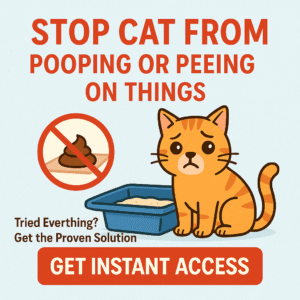Seeing your cat vomit blood is alarming and heartbreaking. It’s a sign of potential serious illness that demands immediate attention. In this detailed guide, you’ll learn what “hematemesis” means, the possible causes, how to triage and protect your cat at home, when to rush to the vet, and how to build a routine that supports their long-term digestive health.
What Is Hematemesis?
Hematemeis is the medical term for vomiting blood. The blood may be bright red (indicating a fresh bleed in the upper GI tract) or dark brown “coffee grounds” (suggesting digested blood further down) :contentReference[oaicite:0]{index=0}. Regardless, any blood is a red flag and should prompt veterinary evaluation.
Common Causes of Blood in Cat Vomit
1. Gastrointestinal Ulcers or Irritation
- Ulcers or inflammation often occur in the stomach or upper intestines; they may result from medications, stress, IBD, or cancer :contentReference[oaicite:1]{index=1}.
2. Foreign Bodies
- Ingested items like string, bones, toys—can scratch or tear tissues, causing bleeding :contentReference[oaicite:2]{index=2}.
3. Infection, Parasites & Toxins
- Severe GI infections (viral, bacterial, parasitic) can injure the lining :contentReference[oaicite:3]{index=3}.
- Toxins like rodenticides or NSAIDs may cause bleeding :contentReference[oaicite:4]{index=4}.
4. Kidney or Liver Disease
- These systemic diseases can disrupt clotting and irritate the GI tract :contentReference[oaicite:5]{index=5}.
5. Blood Clotting Disorders & Trauma
- Conditions like hemophilia or trauma-related injuries may lead to gastrointestinal bleeding :contentReference[oaicite:6]{index=6}.
6. Cancer or Inflammatory Bowel Disease (IBD)
- Gastrointestinal tumors or severe IBD can damage the lining and cause bleeding :contentReference[oaicite:7]{index=7}.
Symptoms to Watch Alongside Bloody Vomit
- Lethargy, weakness, hiding, reduced appetite :contentReference[oaicite:8]{index=8}.
- Diarrhea, with or without blood :contentReference[oaicite:9]{index=9}.
- Abdominal sensitivity or pain when touched :contentReference[oaicite:10]{index=10}.
- Pale gums or signs of anemia :contentReference[oaicite:11]{index=11}.
- Repeated, uncontrolled vomiting or inability to keep water down :contentReference[oaicite:12]{index=12}.
When Is It a Veterinary Emergency?
Any noticeable blood should prompt a call to your vet. Immediate emergency care is required if your cat:
- Succumbs to persistent vomiting or collapse :contentReference[oaicite:13]{index=13}.
- Shows weakness, pale gums, or rapid changes in behavior :contentReference[oaicite:14]{index=14}.
- May have ingested toxins or foreign materials :contentReference[oaicite:15]{index=15}.
Early intervention can be lifesaving—gut integrity and organ function decline quickly in serious cases.
What to Do Right Away
- Collect a sample: If possible, save a bit of the vomit for your vet’s analysis :contentReference[oaicite:16]{index=16}.
- Limit food: Hold food for up to 12 hours; reintroduce bland diet gradually :contentReference[oaicite:17]{index=17}.
- Track frequency: Note how often vomiting occurs and any changes in color or consistency :contentReference[oaicite:18]{index=18}.
- Visit the vet immediately: Early diagnostics improve treatment success.
How Veterinarians Diagnose the Cause
- History and physical examination, including abdominal palpation :contentReference[oaicite:19]{index=19}.
- Blood tests to evaluate organ health, anemia, clotting ability :contentReference[oaicite:20]{index=20}.
- Urinalysis and fecal testing for parasites or toxins :contentReference[oaicite:21]{index=21}.
- Imaging: X-rays, ultrasound, possibly endoscopy to detect foreign bodies, ulcers, tumors :contentReference[oaicite:22]{index=22}.
Treatment Options Based on Cause
Mild Cases
- Resting the GI tract, IV fluids, bland diet, anti-nausea medications :contentReference[oaicite:23]{index=23}.
- Deworming or antibiotics if infection or parasites are detected :contentReference[oaicite:24]{index=24}.
Serious Illnesses
- Surgery to remove blocks or foreign objects :contentReference[oaicite:25]{index=25}.
- Medications for ulcer healing, GI protection, or acid suppression :contentReference[oaicite:26]{index=26}.
- Treatments for organ disease such as fluids, dietary support, or liver/kidney protocols :contentReference[oaicite:27]{index=27}.
- Specialist care or holistic plans for cancer, bleeding disorders, or chronic conditions.
How to Prevent Recurrence
- Keep dangerous objects and poisons out of reach :contentReference[oaicite:28]{index=28}.
- Protect against parasites with regular deworming and preventives :contentReference[oaicite:29]{index=29}.
- Regular veterinary checkups and bloodwork catch early signs :contentReference[oaicite:30]{index=30}.
- Use bland or prescription diets for stress or GI sensitivity :contentReference[oaicite:31]{index=31}.
Building a Health Routine—Inspired by Cat Spray No More
Though focused on eliminating spraying, this ebook’s approach—routine setting, monitoring, environment control—applies perfectly to managing digestive health:
- Track symptoms: Much like litter habits, note vomiting episodes and triggers.
- Maintain consistency: Scheduled meals, stress-reducing toys, and predictable environments support GI stability.
- Routine cleanup: Just as accidents require cleaning, digestive upsets need monitoring and prompt cleaning to avoid reinfection or irritation.
When Cat Spray No More Helps Cat Wellness
This guide offers more than spray defense—it helps you build systems that support your cat’s overall comfort and health. For cats with sensitive GI systems, stress-induced vomiting, or chronic dietary sensitivities, the ebook’s checklists and tracking tools help detect and manage issues before they escalate.
Your Vet Visit Prep Checklist
- Date/time of vomiting and blood appearance
- Quantity and color (fresh vs “coffee grounds”)
- Other symptoms (diarrhea, appetite changes, lethargy)
- Access to toxins or foreign objects
- Recent diet, medication, and environment changes
Conclusion: Act Fast, Build Routine, Stay Hopeful
Finding blood in your cat’s vomit always means something serious is happening. Acting fast—tracking details, contacting your vet, and building supportive routines—is the best way to get them back on track. With the Cat Spray No More ebook’s tools for monitoring, environment care, and calm routines, you’ll feel empowered to protect your cat’s well-being in every way.
Download Cat Spray No More now and bring structure, clarity, and confidence to every aspect of your cat’s care—even critical health concerns.
